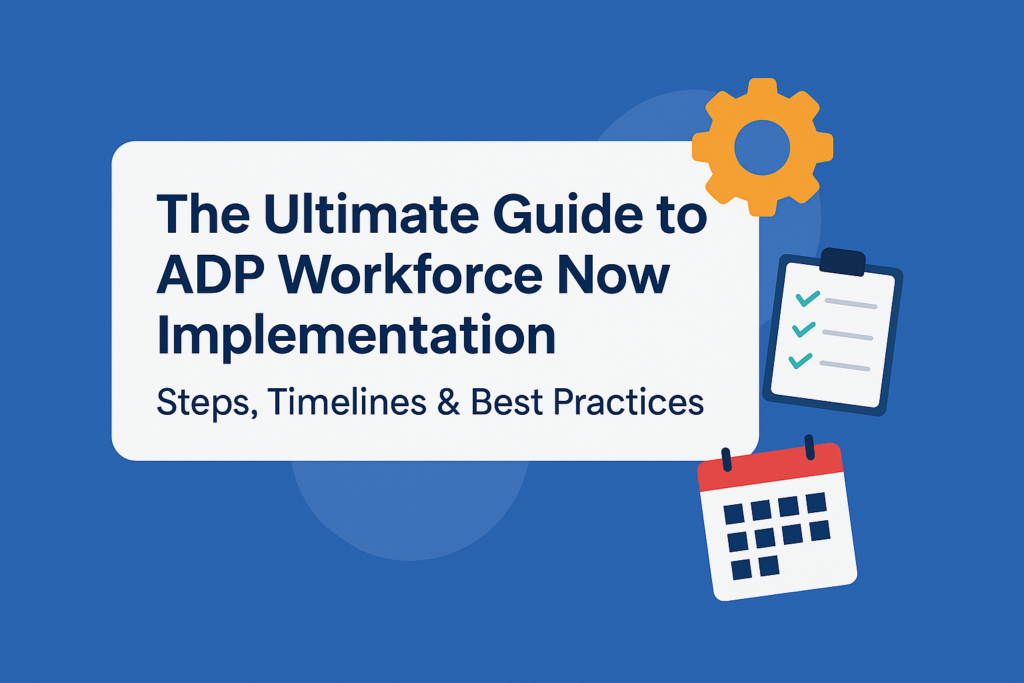In a rapidly evolving global economy, multinational companies face increasing pressure to stay compliant across borders while managing complex HR and payroll systems. Implementing ADP—a leading Human Capital Management (HCM) platform—offers a unified solution to streamline global HR operations. However, success hinges on a strategic implementation process that accounts for diverse compliance requirements across jurisdictions.
This comprehensive guide will walk you through the steps to successfully implement ADP for your multinational organization, with a strong focus on global compliance and operational efficiency.
Why ADP for Multinational Companies?
ADP offers robust payroll and HR solutions tailored for global enterprises. Its features are designed to align with complex international operations, including:
- GlobalView Payroll: Consolidated payroll solution for large multinational firms.
- ADP Celergo: Simplified payroll in over 140 countries for smaller multi-country operations.
- Comprehensive Compliance Tools: Built-in features to handle tax laws, employment regulations, and data privacy.
- Scalable Architecture: Grows with your global footprint.
- Cloud-Based Access: Real-time insights across geographies.
Common Challenges in Global ADP Implementation
Before diving into implementation, it’s crucial to understand the typical hurdles:
- Varying local labor laws and tax regulations
- Data localization and GDPR compliance
- Currency and language differences
- Disconnected legacy systems
- Change management and employee training
Overcoming these challenges requires a tailored, strategic approach with expert guidance.
Step-by-Step ADP Implementation Strategy
Step 1: Assess Global Readiness
Begin by evaluating your organization’s global HR and payroll maturity. Key questions include:
- Are local processes documented?
- How do we currently manage compliance?
- Do we have internal support teams or need external consultants?
Step 2: Define Global and Local Requirements
Partner with in-country HR and legal teams to outline regulatory, tax, and compliance requirements. Document:
- Mandatory fields (TINs, bank details, benefits)
- Country-specific tax treatments
- Workweek definitions, holidays, and overtime rules
Step 3: Choose the Right ADP Solution
Select the right platform based on company size and complexity:
| ADP Solution | Best For | Countries Supported |
|---|---|---|
| ADP GlobalView Payroll | Large enterprises (1000+ employees) | 40+ countries |
| ADP Celergo | SMEs and mid-size firms | 140+ countries |
Step 4: Assemble Your Project Team
Your global ADP implementation team should include:
- Global Project Manager
- Regional HR Leads
- ADP Implementation Partner or Consultant
- Legal & Compliance Officers
- IT Integration Lead
Step 5: Integration with Existing Systems
ADP must work seamlessly with your existing ERP (e.g., SAP, Oracle, Workday) and HR systems. Focus on:
- Data mapping between systems
- APIs and secure data transmission protocols
- Automated data syncs to reduce manual entries
Step 6: Localization and Configuration
Ensure each country’s ADP setup is tailored to its local needs:
- Compliance with wage laws, sick leave, pensions, etc.
- Language preferences
- Country-specific document templates and formats
Step 7: Compliance Validation and Testing
Conduct compliance audits before go-live:
- Perform parallel payroll runs
- Review statutory deductions and benefits accuracy
- Get sign-offs from local legal advisors
Step 8: Training and Change Management
Equip your teams to use ADP effectively with:
- Role-based training sessions
- Multilingual user manuals and video tutorials
- Feedback mechanisms for early adopters
Step 9: Go-Live and Post-Implementation Support
Monitor closely during the first few payroll cycles:
- Set up a helpdesk or dedicated support team
- Track KPIs like error rate, processing time, compliance flags
- Schedule quarterly reviews with ADP and internal stakeholders
Best Practices for Global Compliance with ADP
- Stay Updated: Regulatory changes happen often—subscribe to compliance alerts from ADP.
- Use Dashboards: Leverage ADP’s reporting tools for real-time compliance visibility.
- Audit Regularly: Perform internal audits at least twice a year across regions.
- Centralize Policies: While local laws vary, centralized documentation ensures alignment.
- Partner with Experts: Work with ADP-experienced consultants like ADP Experts to reduce risk.
Why Work with ADP Experts?
At ADPExperts.com, we specialize in helping multinational organizations implement and optimize ADP systems. Our consultants understand the nuances of global compliance and have hands-on experience with ADP GlobalView, Celergo, and other solutions. We ensure every region is configured correctly and supported throughout the journey.
- End-to-end ADP implementation services
- ERP-HCM integration experts
- Custom compliance audits
- 24/7 multinational support
Conclusion
Implementing ADP across multiple countries is more than a software upgrade—it’s a strategic transformation. With the right preparation, localization, and guidance, your organization can unlock global consistency, ensure compliance, and improve employee experience worldwide.
Ready to make your global ADP implementation a success? Contact ADP Experts today for a discovery consultation.





